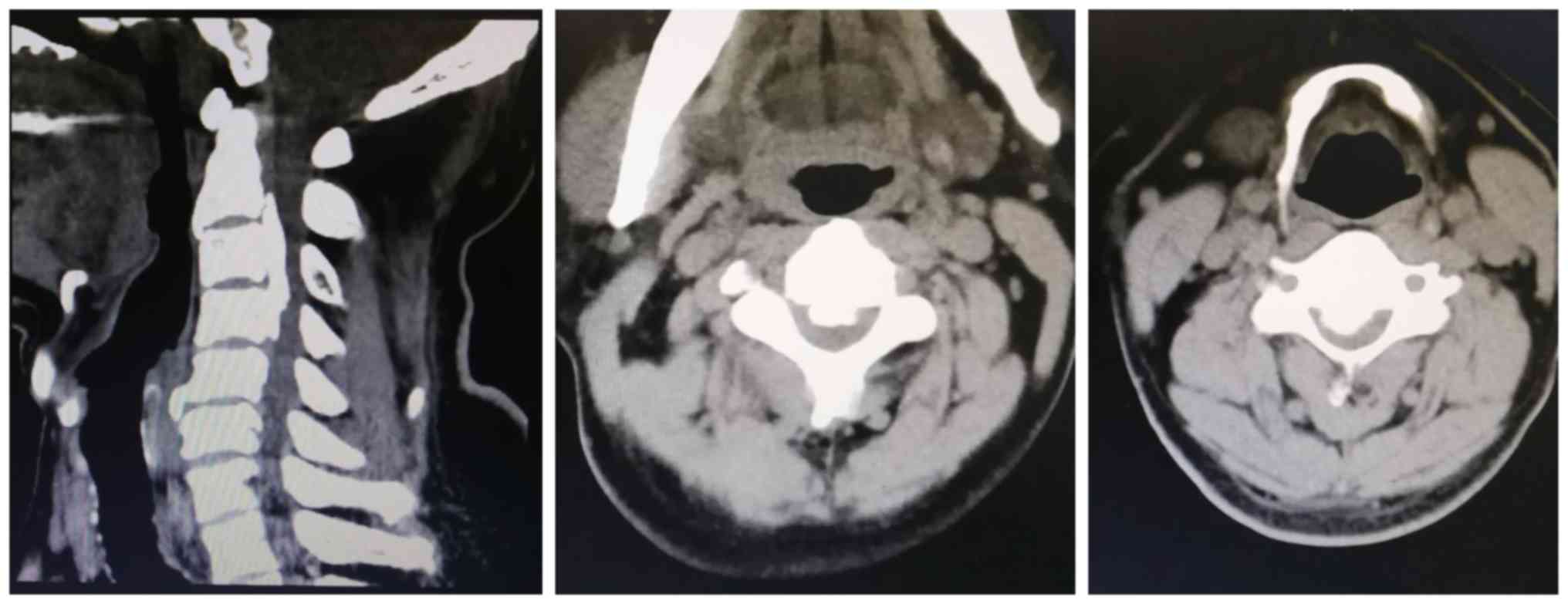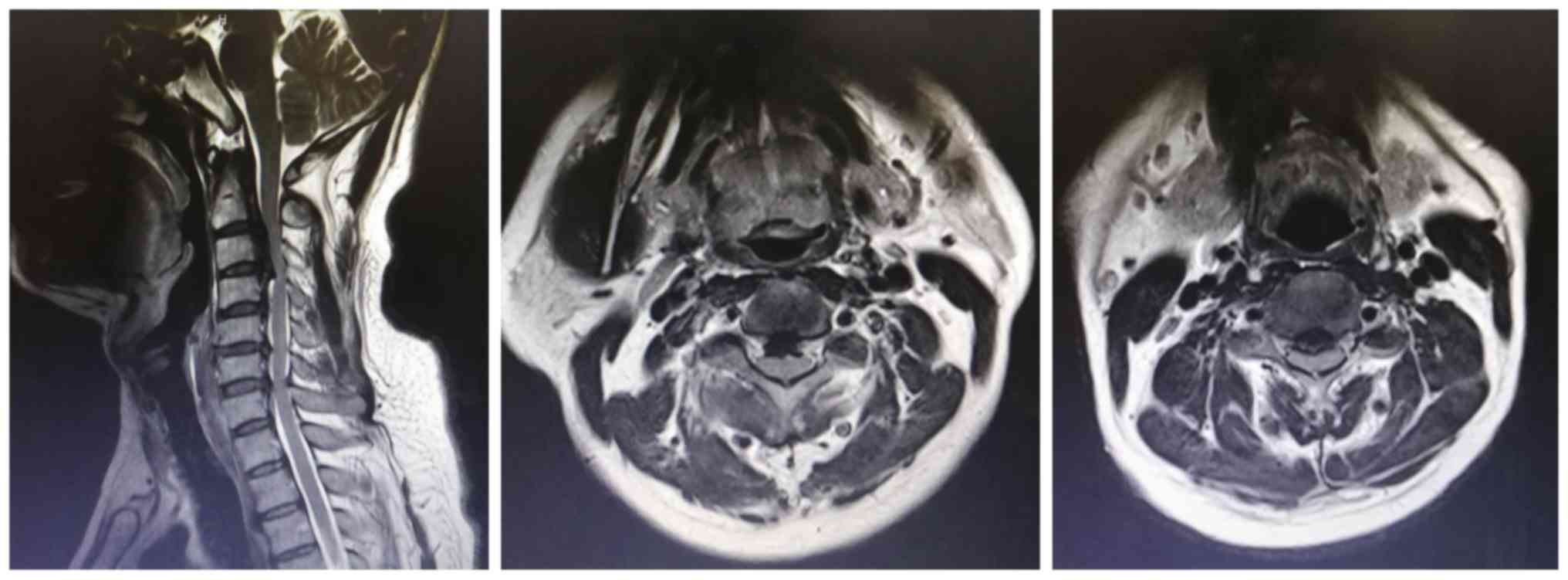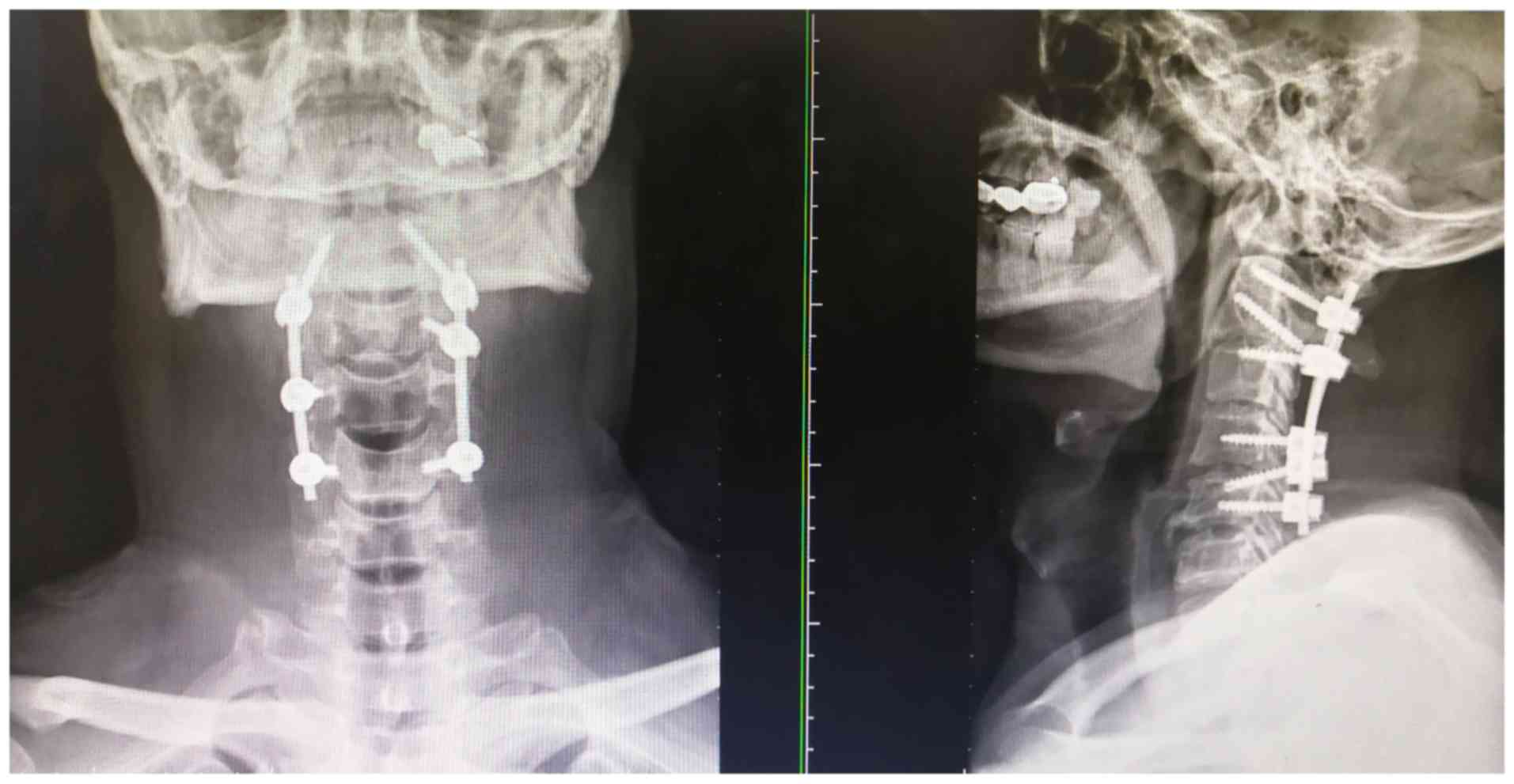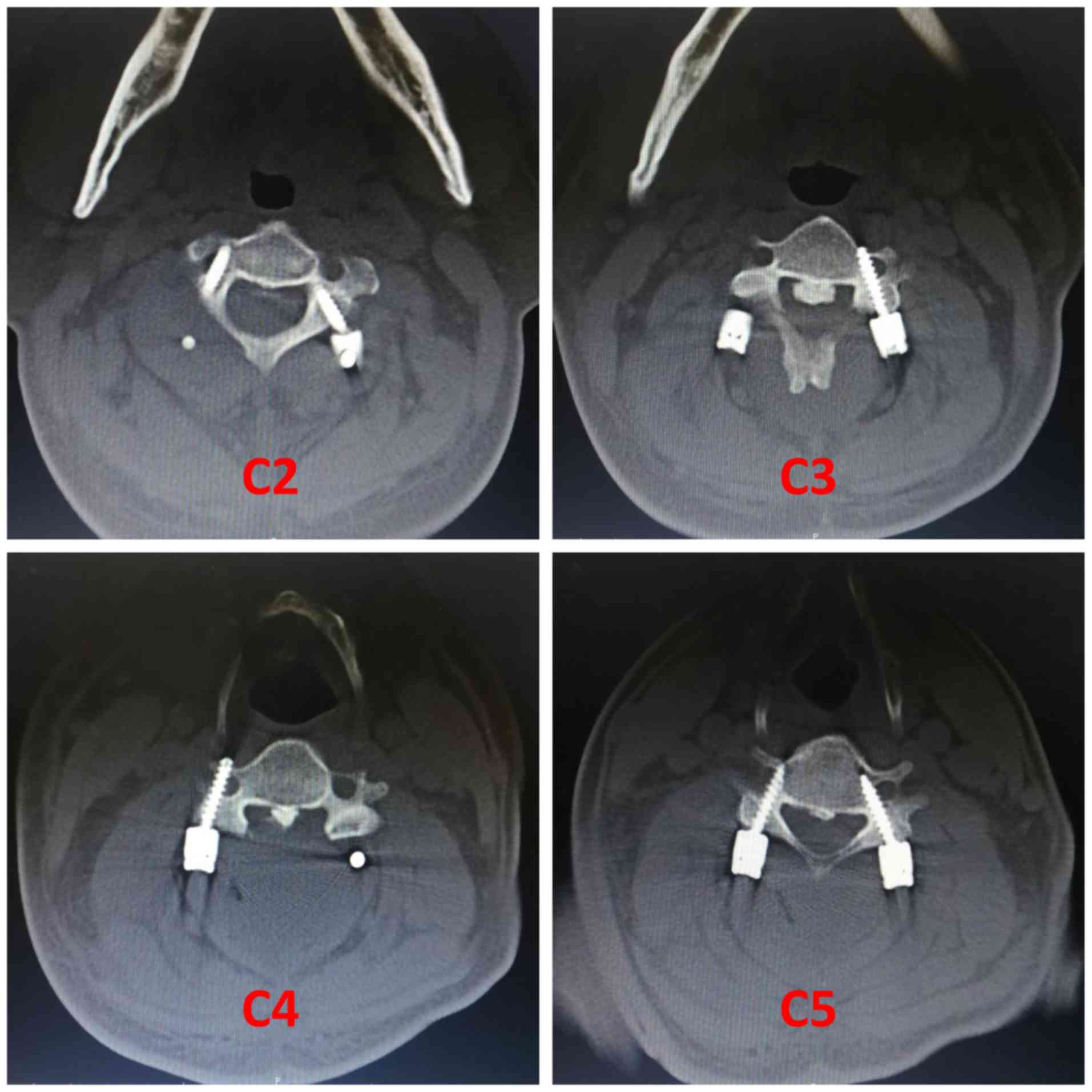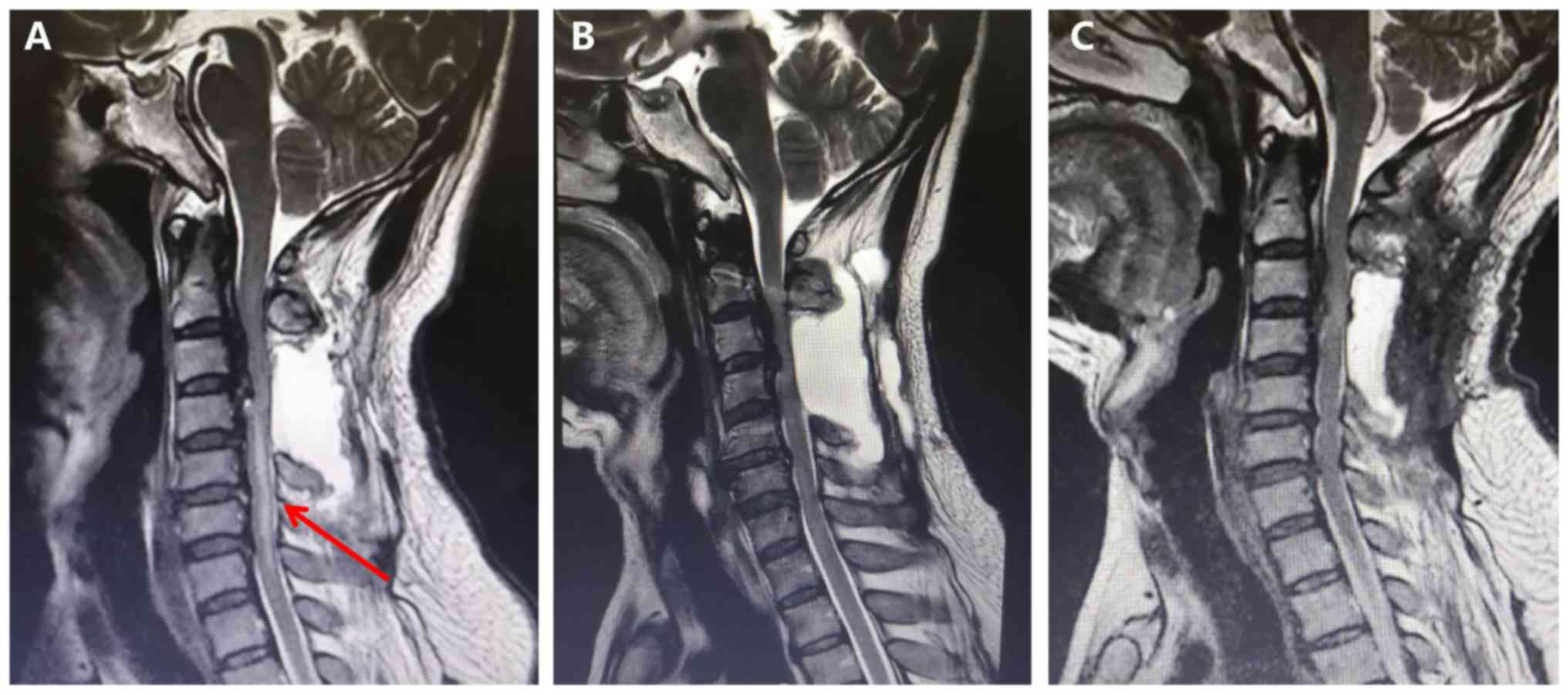|
1
|
Yang T, Wu L, Wang H, Fang J, Yao N and Xu
Y: Inflammation level after decompression surgery for a rat model
of chronic severe spinal cord compression and effects on
ischemia-reperfusion injury. Neurol Med Chir (Tokyo). 55:578–586.
2015.PubMed/NCBI View Article : Google Scholar
|
|
2
|
Chin KR, Seale J and Cumming V: ‘White
cord syndrome’ of acute tetraplegia after anterior cervical
decompression and fusion for chronic spinal cord compression: A
case report. Case Rep Orthop. 2013(697918)2013.PubMed/NCBI View Article : Google Scholar
|
|
3
|
Vinodh VP, Rajapathy SK, Sellamuthu P and
Kandasamy R: White cord syndrome: A devastating complication of
spinal decompression surgery. Surg Neurol Int.
9(136)2018.PubMed/NCBI View Article : Google Scholar
|
|
4
|
Hu S, Dong HL, Li YZ, Luo ZJ, Sun L, Yang
QZ, Yang LF and Xiong L: Effects of remote ischemic preconditioning
on biochemical markers and neurologic outcomes in patients
undergoing elective cervical decompression surgery: A prospective
randomized controlled trial. J Neurosurg Anesthesiol. 22:46–52.
2010.PubMed/NCBI View Article : Google Scholar
|
|
5
|
Young WF and Baron E: Acute neurologic
deterioration after surgical treatment for thoracic spinal
stenosis. J Clin Neurosci. 8:129–132. 2001.PubMed/NCBI View Article : Google Scholar
|
|
6
|
Vanpee G, Hermans G, Segers J and
Gosselink R: Assessment of limb muscle strength in critically ill
patients: A systematic review. Crit Care Med. 42:701–711.
2014.PubMed/NCBI View Article : Google Scholar
|
|
7
|
Bracken MB, Shepard MJ, Collins WF,
Holford TR, Young W, Baskin DS, Eisenberg HM, Flamm E, Leo-Summers
L, Maroon J, et al: A randomized, controlled trial of
methylprednisolone or naloxone in the treatment of acute
spinal-cord injury Results of the Second National acute spinal cord
injury study. N Engl J Med. 322:1405–1411. 1990.PubMed/NCBI View Article : Google Scholar
|
|
8
|
Zhang JD, Xia Q, Ji N, Liu YC, Han Y and
Ning SL: Transient paralysis shortly after anterior cervical
corpectomy and fusion. Orthop Surg. 5:23–28. 2013.PubMed/NCBI View
Article : Google Scholar
|
|
9
|
Jiang X, Shi E, Nakajima Y and Sato S:
Postconditioning, a series of brief interruptions of early
reperfusion, prevents neurologic injury after spinal cord ischemia.
Ann Surg. 244:148–153. 2006.PubMed/NCBI View Article : Google Scholar
|
|
10
|
Back MR, Bandyk M, Bradner M, Cuthbertson
D, Johnson BL, Shames ML and Bandyk DF: Critical analysis of
outcome determinants affecting repair of intact aneurysms involving
the visceral aorta. Ann Vasc Surg. 19:648–656. 2005.PubMed/NCBI View Article : Google Scholar
|
|
11
|
Khan MF, Jooma R, Hashmi FA and Raghib MF:
Delayed spinal cord infarction following anterior cervical surgical
decompression. BMJ Case Rep. 2017(bcr2017219863)2017.PubMed/NCBI View Article : Google Scholar
|
|
12
|
Yamazaki M, Koda M, Okawa A and Aiba A:
Transient paraparesis after laminectomy for thoracic ossification
of the posterior longitudinal ligament and ossification of the
ligamentum flavum. Spinal Cord. 44:130–134. 2006.PubMed/NCBI View Article : Google Scholar
|
|
13
|
Taher F, Lebl DR, Cammisa FP, Pinter DW,
Sun DY and Girardi FP: Transient neurological deficit following
midthoracic decompression for severe stenosis: A series of three
cases. Eur Spine J. 22:2057–2061. 2013.PubMed/NCBI View Article : Google Scholar
|
|
14
|
Yang T, Wu L, Deng X, Yang C, Zhang Y,
Zhang D and Xu Y: Delayed neurological deterioration with an
unknown cause subsequent to surgery for intraspinal meningiomas.
Oncol Lett. 9:2325–2330. 2015.PubMed/NCBI View Article : Google Scholar
|
|
15
|
Wiginton J IV, Brazdzionis J, Mohrdar C,
Sweiss R and Lawandy S: Spinal cord reperfusion injury: Case
report, review of the literature, and future treatment strategies.
Cureus. 11(e5279)2019.PubMed/NCBI View Article : Google Scholar
|
|
16
|
Mathkour M, Werner C, Riffle J, Scullen T,
Dallapiazza RF, Dumont A and Maulucci C: Reperfusion ‘White Cord’
syndrome in cervical spondylotic myelopathy: Does mean arterial
pressure goal make a difference? Additional case and literature
review. World Neurosurg. 137:194–199. 2020.PubMed/NCBI View Article : Google Scholar
|
|
17
|
Antwi P, Grant R, Kuzmik G and Abbed K:
‘White Cord Syndrome’ of acute hemiparesis after posterior cervical
decompression and fusion for chronic cervical stenosis. World
Neurosurg. 113:33–36. 2018.PubMed/NCBI View Article : Google Scholar
|
|
18
|
Papaioannou I, Repantis T, Baikousis A and
Korovessis P: Late-onset ‘White Cord Syndrome’ in an elderly
patient after posterior cervical decompression and fusion: A case
report. Spinal Cord Ser Cases. 5(28)2019.PubMed/NCBI View Article : Google Scholar
|
|
19
|
Jun DS, Baik JM and Lee SK: A case report:
White cord syndrome following anterior cervical discectomy and
fusion: Importance of prompt diagnosis and treatment. BMC
Musculoskelet Disord. 21(157)2020.PubMed/NCBI View Article : Google Scholar
|
|
20
|
Fehlings MG, Wilson JR, Tetreault LA,
Aarabi B, Anderson P, Arnold PM, Brodke DS, Burns AS, Chiba K,
Dettori JR, et al: A Clinical practice guideline for the management
of patients with acute spinal cord injury: Recommendations on the
Use of methylprednisolone sodium succinate. Global Spine J. 7 (3
Suppl):S203–S211. 2017.PubMed/NCBI View Article : Google Scholar
|
|
21
|
Vidal PM, Karadimas SK, Ulndreaj A,
Laliberte AM, Tetreault L, Forner S, Wang J, Foltz WD and Fehlings
MG: Delayed decompression exacerbates ischemia-reperfusion injury
in cervical compressive myelopathy. J CI Insight.
2(e92512)2017.PubMed/NCBI View Article : Google Scholar
|
|
22
|
Vidal PM, Ulndreaj A, Badner A, Hong J and
Fehlings MG: Methylprednisolone treatment enhances early recovery
following surgical decompression for degenerative cervical
myelopathy without compromise to the systemic immune system. J
Neuroinflammation. 15(222)2018.PubMed/NCBI View Article : Google Scholar
|
|
23
|
Sutter M, Eggspuehler A, Jeszenszky D,
Kleinstueck F, Fekete TF, Haschtmann D, Porchet F and Dvorak J: The
impact and value of uni- and multimodal intraoperative
neurophysiological monitoring (IONM) on neurological complications
during spine surgery: A prospective study of 2728 patients. Eur
Spine J. 28:599–610. 2019.PubMed/NCBI View Article : Google Scholar
|
|
24
|
Woodroffe RW, Nourski KV, Helland LC,
Walsh B, Noeller J, Kerezoudis P and Hitchon PW: Management of
iatrogenic spinal cerebrospinal fluid leaks: A cohort of 124
patients. Clin Neurol Neurosurg. 170:61–66. 2018.PubMed/NCBI View Article : Google Scholar
|
|
25
|
Fang Z, Tian R, Jia YT, Xu TT and Liu Y:
Treatment of cerebrospinal fluid leak after spine surgery. Chin J
Traumatol. 20:81–83. 2017.PubMed/NCBI View Article : Google Scholar
|















